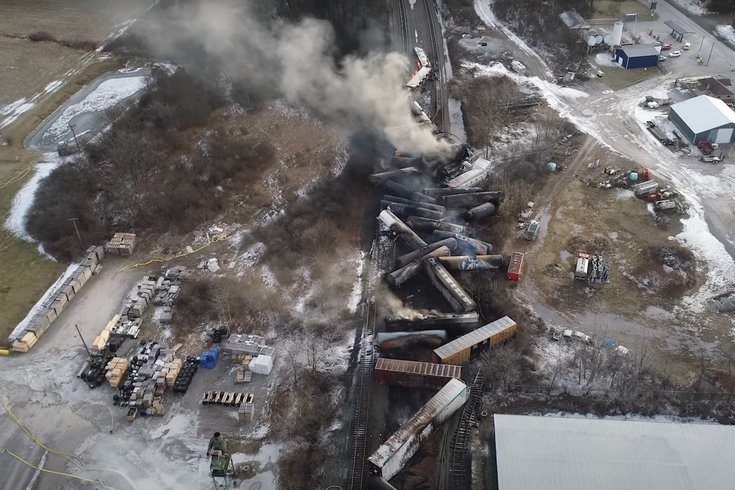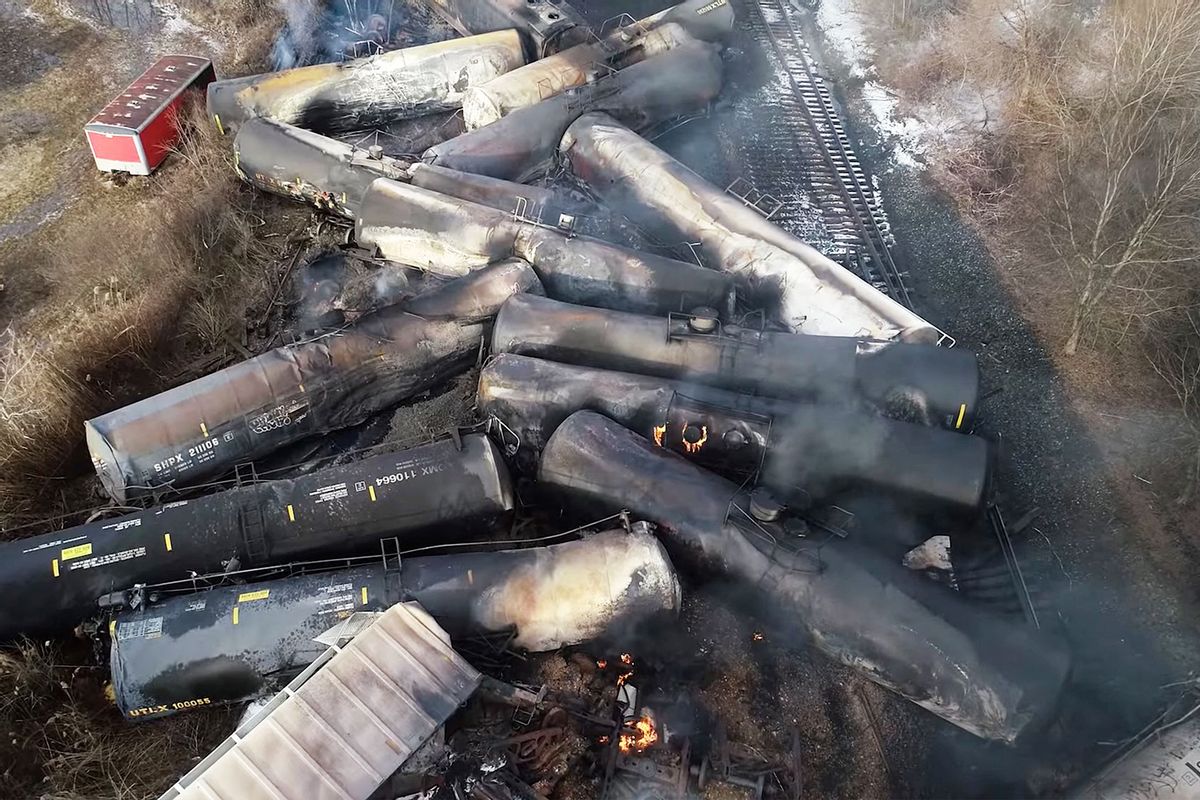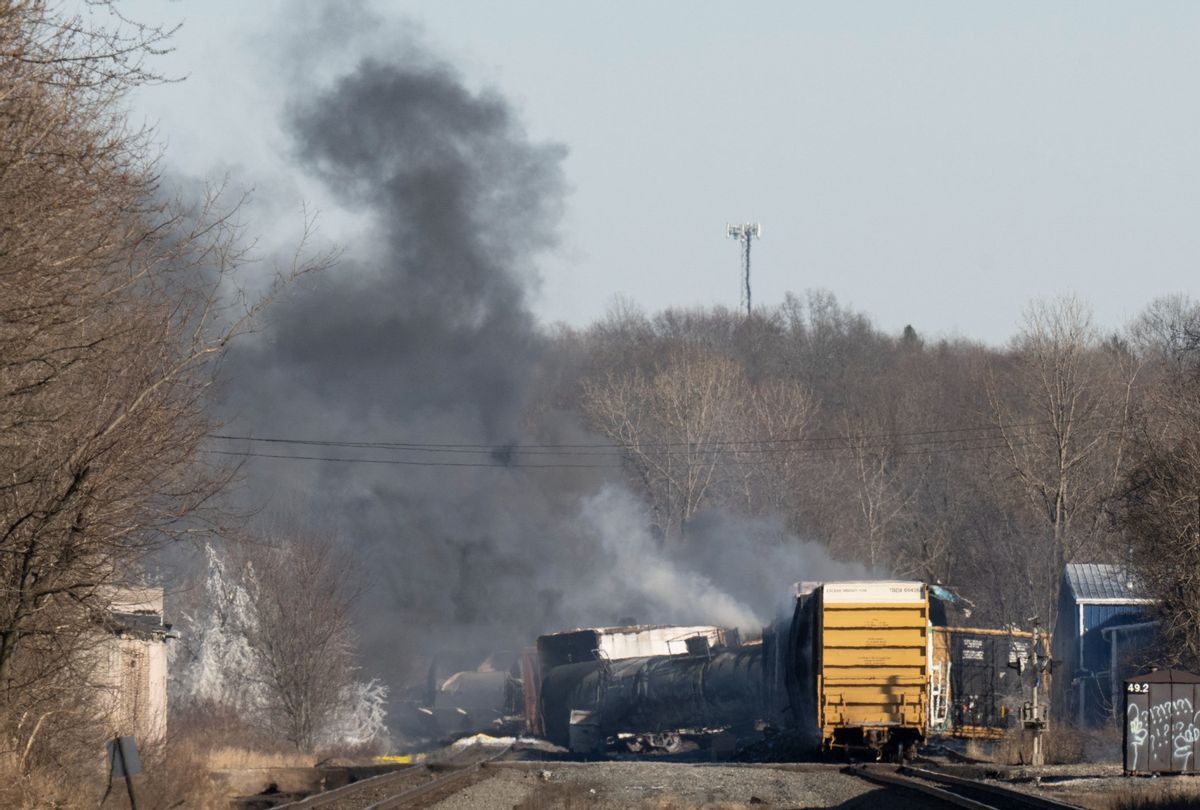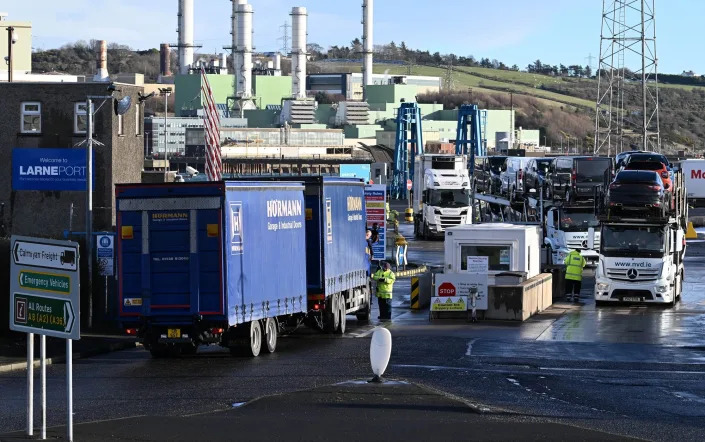BACKGROUNDER
Vinyl chloride, a chemical released in the Ohio train derailment, can damage the liver
High levels of exposure can cause cancer and a liver disease known as TASH. The health impact of lower concentrations are less known
BY JULIANE I. BEIER, UNIVERSITY OF PITTSBURGH
Lessons from 'Rubbertown'
Vinyl chloride is used to produce PVC, a hard plastic used for pipes, as well as in some packaging, coatings and wires.
Its health risks were discovered in the 1970s at a B.F. Goodrich factory in the Rubbertown neighborhood of Louisville, Kentucky. Four workers involved in the polymerization process for producing polyvinyl chloride there each developed angiosarcoma of the liver, an extremely rare type of tumor.
Their cases became among the most important sentinel events in the history of occupational medicine and led to the worldwide recognition of vinyl chloride as a carcinogen.
The liver is the body's filter for removing toxicants from the blood. Specialized cells known as hepatocytes help reduce the toxicity of drugs, alcohol, caffeine and environmental chemicals and then send away the waste to be excreted.
The hallmark of vinyl chloride exposure to the liver is a paradoxical combination of normal liver function tests and the presence of fat in the liver and the death of hepatic cells, which make up the bulk of the liver's mass. However, the detailed mechanisms that lead to vinyl chloride-induced liver disease are still largely unknown.
Recent research has demonstrated that exposure to vinyl chloride, even at levels below the federal limits for safety, can enhance liver disease caused by a "Western diet" – one rich in fat and sugar. This previously unidentified interaction between vinyl chloride and underlying fatty liver diseases raises concerns that the risk from lower vinyl chloride exposures may be underestimated.
Outdoor exposure and the risk from wells
In outdoor air, vinyl chloride becomes diluted fairly quickly. Sunlight also breaks it down, typically in nine to 11 days. Therefore, outdoor air exposure is likely not a problem except with intense periods of exposure, such as immediately following a release of vinyl chloride. If there is a chemical smell, or you feel itchy or disorientated, leave the area and seek medical attention.
Vinyl chloride also disperses in water. The federal Clean Water Act requires monitoring and removing volatile organic compounds such as vinyl chloride from municipal water supplies, so those shouldn't be a concern.
However, private wells could become contaminated if vinyl chloride enters the groundwater. Private wells are not regulated by the Clean Water Act and are not usually monitored.
Vinyl chloride readily volatilizes into the air from water, and it can accumulate in enclosed spaces located above contaminated groundwater. This is especially a concern if the water is heated, such as for showers or during cooking. Vinyl chloride gas in enclosed spaces can therefore accumulate. This effect is similar to recent concerns about fumes from natural gas stoves in poorly ventilated homes.
Although there are established safety levels for acute and intermediate exposure, such levels don't exist for chronic exposures, so testing over time is important.
What can be done? Anyone with a private well that may have been exposed to vinyl chloride should have the well monitored and tested more than once. People can air out their homes and are encouraged to seek medical help if they experience dizziness or itching eyes.
Juliane I. Beier, Assistant Professor of Medicine and Environmental Health, University of Pittsburgh
This article is republished from The Conversation under a Creative Commons license. Read the original article.
High levels of exposure can cause cancer and a liver disease known as TASH. The health impact of lower concentrations are less known
BY JULIANE I. BEIER, UNIVERSITY OF PITTSBURGH
Feb.18,2023


XINHUA/SIPA USA)
The freight train that derailed in East Palestine, Ohio on Feb. 3, 2023 was carrying vinyl chloride, a chemical that can cause liver damage.
Vinyl chloride – the chemical in several of the train cars that derailed and burned in East Palestine, Ohio, earlier this month – can wreak havoc on the human liver.
It has been shown to cause liver cancer, as well as a nonmalignant liver disease known as TASH, or toxicant-associated steatohepatitis. With TASH, the livers of otherwise healthy people can develop the same fat accumulation, inflammation and scarring (fibrosis and cirrhosis) as people who have cirrhosis from alcohol or obesity.
The freight train that derailed in East Palestine, Ohio on Feb. 3, 2023 was carrying vinyl chloride, a chemical that can cause liver damage.
Vinyl chloride – the chemical in several of the train cars that derailed and burned in East Palestine, Ohio, earlier this month – can wreak havoc on the human liver.
It has been shown to cause liver cancer, as well as a nonmalignant liver disease known as TASH, or toxicant-associated steatohepatitis. With TASH, the livers of otherwise healthy people can develop the same fat accumulation, inflammation and scarring (fibrosis and cirrhosis) as people who have cirrhosis from alcohol or obesity.
That kind of damage typically requires relatively high levels of vinyl chloride exposure – the kind an industrial worker might experience on the job.
However, exposures to lower environmental concentrations are still a concern. That's in part because little is known about the impact low-level exposure might have on liver health, especially for people with underlying liver disease and other risks.
As an assistant professor of medicine and environmental and occupational health, I study the impact of vinyl chloride exposure on the liver, particularly on how it may affect people with underlying liver disease. Recent findings have changed our understanding of the risk.
However, exposures to lower environmental concentrations are still a concern. That's in part because little is known about the impact low-level exposure might have on liver health, especially for people with underlying liver disease and other risks.
As an assistant professor of medicine and environmental and occupational health, I study the impact of vinyl chloride exposure on the liver, particularly on how it may affect people with underlying liver disease. Recent findings have changed our understanding of the risk.
Lessons from 'Rubbertown'
Vinyl chloride is used to produce PVC, a hard plastic used for pipes, as well as in some packaging, coatings and wires.
Its health risks were discovered in the 1970s at a B.F. Goodrich factory in the Rubbertown neighborhood of Louisville, Kentucky. Four workers involved in the polymerization process for producing polyvinyl chloride there each developed angiosarcoma of the liver, an extremely rare type of tumor.
Their cases became among the most important sentinel events in the history of occupational medicine and led to the worldwide recognition of vinyl chloride as a carcinogen.
The liver is the body's filter for removing toxicants from the blood. Specialized cells known as hepatocytes help reduce the toxicity of drugs, alcohol, caffeine and environmental chemicals and then send away the waste to be excreted.
The hallmark of vinyl chloride exposure to the liver is a paradoxical combination of normal liver function tests and the presence of fat in the liver and the death of hepatic cells, which make up the bulk of the liver's mass. However, the detailed mechanisms that lead to vinyl chloride-induced liver disease are still largely unknown.
Recent research has demonstrated that exposure to vinyl chloride, even at levels below the federal limits for safety, can enhance liver disease caused by a "Western diet" – one rich in fat and sugar. This previously unidentified interaction between vinyl chloride and underlying fatty liver diseases raises concerns that the risk from lower vinyl chloride exposures may be underestimated.
Outdoor exposure and the risk from wells
In outdoor air, vinyl chloride becomes diluted fairly quickly. Sunlight also breaks it down, typically in nine to 11 days. Therefore, outdoor air exposure is likely not a problem except with intense periods of exposure, such as immediately following a release of vinyl chloride. If there is a chemical smell, or you feel itchy or disorientated, leave the area and seek medical attention.
Vinyl chloride also disperses in water. The federal Clean Water Act requires monitoring and removing volatile organic compounds such as vinyl chloride from municipal water supplies, so those shouldn't be a concern.
However, private wells could become contaminated if vinyl chloride enters the groundwater. Private wells are not regulated by the Clean Water Act and are not usually monitored.
Vinyl chloride readily volatilizes into the air from water, and it can accumulate in enclosed spaces located above contaminated groundwater. This is especially a concern if the water is heated, such as for showers or during cooking. Vinyl chloride gas in enclosed spaces can therefore accumulate. This effect is similar to recent concerns about fumes from natural gas stoves in poorly ventilated homes.
Although there are established safety levels for acute and intermediate exposure, such levels don't exist for chronic exposures, so testing over time is important.
What can be done? Anyone with a private well that may have been exposed to vinyl chloride should have the well monitored and tested more than once. People can air out their homes and are encouraged to seek medical help if they experience dizziness or itching eyes.

Juliane I. Beier, Assistant Professor of Medicine and Environmental Health, University of Pittsburgh
This article is republished from The Conversation under a Creative Commons license. Read the original article.
Despite reassurances from public officials, concerns linger about a train derailment that released toxic chemicals
By TROY FARAH
SALON

Many are drawing comparisons to the 1986 Chernobyl nuclear disaster, which turned Pripyat, a city of roughly 50,000 people, into a ghost town. "We basically nuked a town with chemicals so we could get a railroad open," Sil Caggiano, a hazardous materials specialist, told WKBN.
On Feb. 6, Gov. Mike DeWine, R-Ohio, and Gov. Josh Shapiro, D-Penn., ordered an immediate evacuation in a one-mile by two-mile area surrounding East Palestine, which includes parts of both Ohio and Pennsylvania. Five of the rail cars containing vinyl chloride, a toxic gas, had become unstable, threatening the risk of an explosion that would blast shrapnel and toxic fumes a mile in every direction, according to an analysis by the Ohio National Guard and U.S. Department of Defense.
Chelsea Handler, Kathy Griffin and more on finding resilience with comedyKeep Watching
A controlled burn was seen as the best alternative, but anyone who directly breathed in the smog would be risking their lives.
"Based on current weather patterns and the expected flow of the smoke and fumes, anyone who remains in the red affected area is facing grave danger of death," DeWine's office warned in a press release. "Anyone who remains in the yellow impacted area is at a high risk of severe injury, including skin burns and serious lung damage."
A few days later, on Feb. 8, state officials told residents that they could "safely" return home, and the air was safe to breathe. However, they encouraged residents not to drink well water.
"Air quality samples in the area of the wreckage and in nearby residential neighborhoods have consistently showed readings at points below safety screening levels for contaminants of concern," DeWine's office said in a press release. "Based on this information, state and local health officials determined that it is now safe for community members to return to their residences."
Advertisement:
"If it's safe and habitable, then why does it hurt? Why does it hurt me to breathe?"
But some locals are distrustful of this advice, concerned by lingering odors of chlorine that are reportedly causing some individuals to experience headaches. "If it's safe and habitable, then why does it hurt?" Nathen Velez, a resident of East Palestine, said to CNN. "Why does it hurt me to breathe?"
"This is why people don't trust government," environmental activist Erin Brockovich tweeted on Feb. 13. "You cannot tell people that there has been and continues to be hazardous pollutants contaminating the environment while at the same time saying 'all is well.' People aren't stupid."
As more details emerge, the gravity of the situation only seems to worsen. In a letter sent to Norfolk Southern Railway on Feb. 11, the Environmental Protection Agency (EPA) said that in addition to vinyl chloride, four additional toxic chemicals were on board the train: ethylene glycol monobutyl ether, ethylhexyl acrylate, butyl acrylate and isobutylene.
While these chemical names may sound like gibberish to most people, experts believe these substances pose critical health risks. Isobutylene, for example, is a flammable gas used to make airtight polymers such as bottle stoppers, O-rings or window seals. If inhaled, isobutylene irritates the lungs; it can also impact the heart and central nervous system.
Then there's ethylhexyl acrylate, a chemical used in paint binding and stain resistors. Inhalation or skin contact with the liquid can cause respiratory tract irritation and irritate the eyes and skin. Butyl acrylate is a colorless liquid with a sharp odor used in paints, caulks, sealants and adhesives. It can trigger difficulties breathing and irritation of the eyes and skin. On Wednesday, the Ohio city of Steubenville detected butyl acrylate in its water intake, though officials said it would be removed from the river using powder activated carbon.
:
Finally, there's ethylene glycol monobutyl ether, sometimes known as 2-butoxyethanol, which is used as a solvent, as well as to make paints and varnish. It can also irritate the eyes and lungs if inhaled, and it has been shown to cause cancer in animals, but data in humans is lacking.
The worst of the bunch, however, is seemingly vinyl chloride. Out of the roughly 150 rail cars, of which 50 derailed, five of them contained the stuff, a highly-flammable toxic gas with a faintly sweet odor that is used in the production of plastics like PVC, also known as polyvinyl chloride. (That poly part of the chemical name makes a big difference.) Vinyl chloride is extremely noxious to inhale. Our bodies readily absorb it, causing significant damage to the respiratory and central nervous systems.
Want more health and science stories in your inbox? Subscribe to Salon's weekly newsletter The Vulgar Scientist.
As the liver metabolizes vinyl chloride, it spits out a chemical called chloroethylene oxide, which subsequently binds to our DNA, essentially vandalizing it and increasing the risk of tumor formation. As such, massive exposure to vinyl chloride is associated with a host of lung, liver, brain and blood cancers.
But when the vinyl chloride was burned, the chemical reaction generates new corrosive chemicals: phosgene gas and hydrogen chloride. The first, which has a history of being used in chemical warfare during World War I, can cause coughing, blurred vision, difficulty breathing, nausea, vomiting and death. The severity of symptoms depends on the level of exposure, but phosgene has also been linked to low blood pressure, heart failure and coughing up white to pink-tinged fluid, which is a sign of pulmonary edema, or fluid buildup in the lungs.
As for hydrogen chloride, the compound is normally stable, but at high temperatures, it bonds to water molecules easily. This creates hydrochloric acid, which is highly corrosive. When it falls from the sky, it creates acid rain, which is known to kill trees and wildlife.
While some of these chemicals will quickly fade from the environment, according to officials, others may linger. As of Tuesday, Feb. 14, the EPA said it had screened 459 homes, with 39 remaining to be screened. "To date, no detections of vinyl chloride or hydrogen chloride were identified for the completed screened homes," the EPA said in a statement.
Salon has reached out to the EPA and will update this article if a response is received.
The EPA and other agencies are actively monitoring water for contaminants. So far, the derailment is reportedly far enough away from watersheds and local water supplies that it doesn't pose a risk to residents. Nonetheless, the Ohio Farm Bureau Federation has urged members to get the water from their local wells tested as soon as possible.
Given that an estimated 100,000 gallons of vinyl chloride was released into the environment, it's perhaps understandable that some residents are wary of such reassurances. Some residents have vowed to seek independent testing while a flurry of lawsuits are brewing.
No one should have to undertake complex chemistry lessons to figure out if their home is safe or not.
No one should have to undertake complex chemistry lessons to figure out if their home is safe or not. Despite the comparisons to nuclear disasters, the East Palestine train derailment has more in common with a 2012 train derailment in Gloucester County, N.J. Similar to the current incident, a train derailed after hitting a collapsed bridge and released 23,000 gallons of vinyl chloride that wafted into nearby Paulsboro, prompting evacuations.
Some, including DeWine, have questioned if these derailments are preventable with better regulation. At a Tuesday press conference, DeWine mentioned Norfolk Southern was not legally required to alert Ohioans regarding the toxic cargo.
"Frankly, if this is true — and I'm told it's true — this is absurd," DeWine said. "Congress needs to take a look at how these things are handled."
In fact, industry lobbyists have invested considerable effort into blocking reforms. Railroad Workers United, a cross-union rail workers' reform group, told The New Republic that the cause of the wreck "appears to have been a 19th-century style mechanical failure of the axle on one of the cars — an overheated bearing — leading to derailment and then jackknifing tumbling cars."
This mechanical failure could have been averted with better equipment, but reforms have been blocked. In 2017, rail industry donors shoveled more than $6 million in funds to Republican campaigns, including the Trump administration, which later rescinded rules related to train braking systems, according to The Lever. If the train had brakes from this century, this disaster could potentially have been avoided, but Norfolk Southern's "lobby group nonetheless pressed for the rule's repeal, telling regulators that it would "impose tremendous costs without providing offsetting safety benefits," the Lever reported.
Norfolk Southern responded to Salon's request for comment by referring to a pair of press releases detailing community assistance efforts, such as establishing a $1 million fund to support East Palestine community.
Until more data becomes available, it's difficult to say exactly how damaging and far-reaching the effects of this disaster will be. Given the scale of the problem and the risks involved, the public is right to demand answers. Clearly, the railroad industry could use more oversight to update trains from obsolete Civil War-era technology. Only time will tell whether the comparisons to Chernobyl or nuclear bombs are accurate, but updating our transportation industry is something that could help us all breathe a little easier.
By TROY FARAH
Troy Farah is a science and public health journalist whose reporting has appeared in Scientific American, STAT News, Undark, VICE, and others. He co-hosts the drug policy and science podcast Narcotica. His website is troyfarah.com and can be found on Twitter at @filth_filler
Staff Writer
PUBLISHED FEBRUARY 15, 2023
PUBLISHED FEBRUARY 15, 2023

Drone footage shows the freight train derailment in East Palestine, Ohio, U.S., February 6, 2023 in this screengrab obtained from a handout video released by the NTSB.
(National Transportation Safety Board/WikiCommons)
A massive environmental disaster has sent social media into a tailspin for days, following a train derailment in Ohio that leeched toxic chemicals into the ground, water and air.
On Feb. 3, a train of about 150 freight cars — many carrying several loads of hazardous materials — crashed and exploded in the town of East Palestine, Ohio. The tangled knot of boxcars operated by Norfolk Southern Railway shot out flames reaching 100 feet and sent a massive plume of coal-black smog into the air that could be seen for miles. Luckily, no direct injuries or deaths were reported. Five days later, crews ignited a controlled burn of the toxic chemicals in order to prevent a much bigger explosion, but the situation appears to be worsening.
The local motto for East Palestine, which has a population just shy of 5,000 people, is apparently "The Place You Want To Be," but that sentiment may be less popular right now. Residents and local news agencies have posted viral videos of streams and creeks cluttered with dead fish and frogs, as well as images of the sky darkened with black smoke. Reports have also surfaced that fumes sickened and even killed pets.
A massive environmental disaster has sent social media into a tailspin for days, following a train derailment in Ohio that leeched toxic chemicals into the ground, water and air.
On Feb. 3, a train of about 150 freight cars — many carrying several loads of hazardous materials — crashed and exploded in the town of East Palestine, Ohio. The tangled knot of boxcars operated by Norfolk Southern Railway shot out flames reaching 100 feet and sent a massive plume of coal-black smog into the air that could be seen for miles. Luckily, no direct injuries or deaths were reported. Five days later, crews ignited a controlled burn of the toxic chemicals in order to prevent a much bigger explosion, but the situation appears to be worsening.
The local motto for East Palestine, which has a population just shy of 5,000 people, is apparently "The Place You Want To Be," but that sentiment may be less popular right now. Residents and local news agencies have posted viral videos of streams and creeks cluttered with dead fish and frogs, as well as images of the sky darkened with black smoke. Reports have also surfaced that fumes sickened and even killed pets.
Related
Many are drawing comparisons to the 1986 Chernobyl nuclear disaster, which turned Pripyat, a city of roughly 50,000 people, into a ghost town. "We basically nuked a town with chemicals so we could get a railroad open," Sil Caggiano, a hazardous materials specialist, told WKBN.
On Feb. 6, Gov. Mike DeWine, R-Ohio, and Gov. Josh Shapiro, D-Penn., ordered an immediate evacuation in a one-mile by two-mile area surrounding East Palestine, which includes parts of both Ohio and Pennsylvania. Five of the rail cars containing vinyl chloride, a toxic gas, had become unstable, threatening the risk of an explosion that would blast shrapnel and toxic fumes a mile in every direction, according to an analysis by the Ohio National Guard and U.S. Department of Defense.
Chelsea Handler, Kathy Griffin and more on finding resilience with comedyKeep Watching
A controlled burn was seen as the best alternative, but anyone who directly breathed in the smog would be risking their lives.
"Based on current weather patterns and the expected flow of the smoke and fumes, anyone who remains in the red affected area is facing grave danger of death," DeWine's office warned in a press release. "Anyone who remains in the yellow impacted area is at a high risk of severe injury, including skin burns and serious lung damage."
A few days later, on Feb. 8, state officials told residents that they could "safely" return home, and the air was safe to breathe. However, they encouraged residents not to drink well water.
"Air quality samples in the area of the wreckage and in nearby residential neighborhoods have consistently showed readings at points below safety screening levels for contaminants of concern," DeWine's office said in a press release. "Based on this information, state and local health officials determined that it is now safe for community members to return to their residences."
Advertisement:
"If it's safe and habitable, then why does it hurt? Why does it hurt me to breathe?"
But some locals are distrustful of this advice, concerned by lingering odors of chlorine that are reportedly causing some individuals to experience headaches. "If it's safe and habitable, then why does it hurt?" Nathen Velez, a resident of East Palestine, said to CNN. "Why does it hurt me to breathe?"
"This is why people don't trust government," environmental activist Erin Brockovich tweeted on Feb. 13. "You cannot tell people that there has been and continues to be hazardous pollutants contaminating the environment while at the same time saying 'all is well.' People aren't stupid."
As more details emerge, the gravity of the situation only seems to worsen. In a letter sent to Norfolk Southern Railway on Feb. 11, the Environmental Protection Agency (EPA) said that in addition to vinyl chloride, four additional toxic chemicals were on board the train: ethylene glycol monobutyl ether, ethylhexyl acrylate, butyl acrylate and isobutylene.
While these chemical names may sound like gibberish to most people, experts believe these substances pose critical health risks. Isobutylene, for example, is a flammable gas used to make airtight polymers such as bottle stoppers, O-rings or window seals. If inhaled, isobutylene irritates the lungs; it can also impact the heart and central nervous system.
Then there's ethylhexyl acrylate, a chemical used in paint binding and stain resistors. Inhalation or skin contact with the liquid can cause respiratory tract irritation and irritate the eyes and skin. Butyl acrylate is a colorless liquid with a sharp odor used in paints, caulks, sealants and adhesives. It can trigger difficulties breathing and irritation of the eyes and skin. On Wednesday, the Ohio city of Steubenville detected butyl acrylate in its water intake, though officials said it would be removed from the river using powder activated carbon.
:
Finally, there's ethylene glycol monobutyl ether, sometimes known as 2-butoxyethanol, which is used as a solvent, as well as to make paints and varnish. It can also irritate the eyes and lungs if inhaled, and it has been shown to cause cancer in animals, but data in humans is lacking.
The worst of the bunch, however, is seemingly vinyl chloride. Out of the roughly 150 rail cars, of which 50 derailed, five of them contained the stuff, a highly-flammable toxic gas with a faintly sweet odor that is used in the production of plastics like PVC, also known as polyvinyl chloride. (That poly part of the chemical name makes a big difference.) Vinyl chloride is extremely noxious to inhale. Our bodies readily absorb it, causing significant damage to the respiratory and central nervous systems.
Want more health and science stories in your inbox? Subscribe to Salon's weekly newsletter The Vulgar Scientist.
As the liver metabolizes vinyl chloride, it spits out a chemical called chloroethylene oxide, which subsequently binds to our DNA, essentially vandalizing it and increasing the risk of tumor formation. As such, massive exposure to vinyl chloride is associated with a host of lung, liver, brain and blood cancers.
But when the vinyl chloride was burned, the chemical reaction generates new corrosive chemicals: phosgene gas and hydrogen chloride. The first, which has a history of being used in chemical warfare during World War I, can cause coughing, blurred vision, difficulty breathing, nausea, vomiting and death. The severity of symptoms depends on the level of exposure, but phosgene has also been linked to low blood pressure, heart failure and coughing up white to pink-tinged fluid, which is a sign of pulmonary edema, or fluid buildup in the lungs.
As for hydrogen chloride, the compound is normally stable, but at high temperatures, it bonds to water molecules easily. This creates hydrochloric acid, which is highly corrosive. When it falls from the sky, it creates acid rain, which is known to kill trees and wildlife.
While some of these chemicals will quickly fade from the environment, according to officials, others may linger. As of Tuesday, Feb. 14, the EPA said it had screened 459 homes, with 39 remaining to be screened. "To date, no detections of vinyl chloride or hydrogen chloride were identified for the completed screened homes," the EPA said in a statement.
Salon has reached out to the EPA and will update this article if a response is received.
The EPA and other agencies are actively monitoring water for contaminants. So far, the derailment is reportedly far enough away from watersheds and local water supplies that it doesn't pose a risk to residents. Nonetheless, the Ohio Farm Bureau Federation has urged members to get the water from their local wells tested as soon as possible.
Given that an estimated 100,000 gallons of vinyl chloride was released into the environment, it's perhaps understandable that some residents are wary of such reassurances. Some residents have vowed to seek independent testing while a flurry of lawsuits are brewing.
No one should have to undertake complex chemistry lessons to figure out if their home is safe or not.
No one should have to undertake complex chemistry lessons to figure out if their home is safe or not. Despite the comparisons to nuclear disasters, the East Palestine train derailment has more in common with a 2012 train derailment in Gloucester County, N.J. Similar to the current incident, a train derailed after hitting a collapsed bridge and released 23,000 gallons of vinyl chloride that wafted into nearby Paulsboro, prompting evacuations.
Some, including DeWine, have questioned if these derailments are preventable with better regulation. At a Tuesday press conference, DeWine mentioned Norfolk Southern was not legally required to alert Ohioans regarding the toxic cargo.
"Frankly, if this is true — and I'm told it's true — this is absurd," DeWine said. "Congress needs to take a look at how these things are handled."
In fact, industry lobbyists have invested considerable effort into blocking reforms. Railroad Workers United, a cross-union rail workers' reform group, told The New Republic that the cause of the wreck "appears to have been a 19th-century style mechanical failure of the axle on one of the cars — an overheated bearing — leading to derailment and then jackknifing tumbling cars."
This mechanical failure could have been averted with better equipment, but reforms have been blocked. In 2017, rail industry donors shoveled more than $6 million in funds to Republican campaigns, including the Trump administration, which later rescinded rules related to train braking systems, according to The Lever. If the train had brakes from this century, this disaster could potentially have been avoided, but Norfolk Southern's "lobby group nonetheless pressed for the rule's repeal, telling regulators that it would "impose tremendous costs without providing offsetting safety benefits," the Lever reported.
Norfolk Southern responded to Salon's request for comment by referring to a pair of press releases detailing community assistance efforts, such as establishing a $1 million fund to support East Palestine community.
Until more data becomes available, it's difficult to say exactly how damaging and far-reaching the effects of this disaster will be. Given the scale of the problem and the risks involved, the public is right to demand answers. Clearly, the railroad industry could use more oversight to update trains from obsolete Civil War-era technology. Only time will tell whether the comparisons to Chernobyl or nuclear bombs are accurate, but updating our transportation industry is something that could help us all breathe a little easier.
By TROY FARAH
Troy Farah is a science and public health journalist whose reporting has appeared in Scientific American, STAT News, Undark, VICE, and others. He co-hosts the drug policy and science podcast Narcotica. His website is troyfarah.com and can be found on Twitter at @filth_filler
“Environmental disaster”: Ohio train disaster spews toxic chemicals after years of GOP deregulation
The East Palestine derailment is the "latest in a long string of corporate malfeasance"
By KENNY STANCIL
SALON
PUBLISHED FEBRUARY 15, 2023
Hauser was joined Tuesday by environmental activist Erin Brockovich, who tweeted, "The Biden administration needs to get more involved in this... train derailment now."
"We are counting on you to break the chain of administration after administration to turn a blind eye," she added. "STEP UP NOW."
After Buttigieg made his first public statement on the East Palestine disaster on Monday night—10 days after dozens of train cars careened off the tracks and burst into flames—The Lever's David Sirota issued a reminder that the transportation secretary is actively considering an industry-backed proposal to further weaken the regulation of train braking systems.
Sirota also urged people to sign his outlet's open letter imploring Buttigieg "to rectify the multiple regulatory failures that preceded this horrific situation," including by exercising his authority to restore the rail safety rules gutted by Trump at the behest of industry lobbyists.
Rep. Ilhan Omar, D-Minn., wrote Monday night on social media that the freight train crash and ensuing chemical release "will have a significant negative impact on the health and well-being of the residents for decades."
"We need [a] congressional inquiry and direct action from Pete Buttigieg to address this tragedy," added the progressive lawmaker.
Following the February 3 derailment of a 150-car train carrying hazardous materials—described by an inter-union alliance of rail workers as the predictable result of Wall Street-backed policies that prioritize profits over safety—officials ordered emergency evacuations before releasing chemicals into a trench and burning them off to prevent a catastrophic explosion.
It was already known that vinyl chloride, of particular concern to state health officials because exposure to the volatile gas is associated with higher cancer risks, had been released from several cars, and that other dangerous toxins such as phosgene and hydrogen chloride were emitted in large plumes of smoke.
However, citing a list of the derailed car contents that Norfolk Southern provided to the U.S. Environmental Protection Agency (EPA), ABC Newsreported Monday night that several more toxic substances were released into the air and soil following the crash than originally thought, including ethylene glycol monobutyl ether, ethylhexyl acrylate, and isobutylene.
As the outlet noted:
Contact with ethylhexyl acrylate, a carcinogen, can cause burning and irritation of the skin and eyes, and inhalation can irritate the nose and throat, causing shortness of breath and coughing, according to the Centers for Disease Control and Prevention.
Inhalation of isobutylene can cause dizziness and drowsiness as well, while exposure to ethylene glycol monobutyl ether can caused irritation in the eyes, skin, nose, and throat, as well as hematuria, or blood in the urine, nervous system depression, headache, and vomiting, according to the CDC.
The U.S. EPA said Monday night that it "has not yet detected any concerning levels of toxins in the air quality that can be attributed to the crash since the controlled burn was complete," ABC News reported. The agency continues to screen individual homes in close proximity to the site.
Meanwhile, The Independent reported Tuesday that the Ohio EPA has confirmed the presence of chemicals, including butyl acrylate, in the Ohio River basin, potentially affecting up to 25 million people.
Contaminants reached the river from an initial spill caused by the derailment, but officials said they "were in low enough level that the river diluted them and said that downriver communities would not be at risk," the outlet reported. The state agency "has been monitoring water quality throughout the region and has not found contaminant levels at any levels they've deemed concerning."
Nevertheless, the Ohio Department of Natural Resources has revealed that at least 3,500 fish have died in Columbiana County, home to East Palestine, since the derailment.
As the full ecological fallout of the disaster continues to come into view, many of East Palestine's roughly 4,700 residents fear that the air and water in the rural town they have been told is safe to return to remains hazardous to their health. At least 2,000 residents have returned, however, due in large part to a lack of viable alternatives owing to their limited resources and incomes.
Norfolk Southern, which reported record-breaking operating revenues of $12.7 billion in 2022, has offered to donate just $25,000 to help affected residents, amounting to roughly $5 per person.
The corporation announced a $10 billion stock buyback program last March and has consistently increased its dividend, rewarding shareholders while refusing to provide its workers with basic benefits such as paid sick leave.
"Rather than spending money to upgrade safety and staffing, Norfolk Southern engaged in stock buybacks and laid off employees," Rep. Jim McGovern, D-Mass., tweeted Tuesday. "Union workers were ignored. The train went up in flames and toxic chemicals are causing a colossal environmental catastrophe. There must be accountability."
The East Palestine derailment is the "latest in a long string of corporate malfeasance"
By KENNY STANCIL
SALON
PUBLISHED FEBRUARY 15, 2023

Smoke rises from a derailed cargo train in East Palestine, Ohio, on February 4, 2023.
(DUSTIN FRANZ/AFP via Getty Images)
This article originally appeared at Common Dreams. It is licensed under a Creative Commons Attribution-Share Alike 3.0 License. Feel free to republish and share widely.
Progressives are demanding that U.S. Transportation Secretary Pete Buttigieg improve rail safety regulations in response to the unfolding public health disaster in East Palestine, Ohio—the site of a recent fiery train crash and subsequent "controlled release" of toxic fumes that critics say was entirely avoidable.
"The Obama administration attempted to prevent dangerous derailments like the one in East Palestine by mandating better brake systems on freight trains," Jeff Hauser, executive director of the Revolving Door Project, said Tuesday in a statement. "But this effort was watered down thanks to corporate pressure, first by writing in many exemptions to the proposed rules and then, under [former President Donald] Trump, by repealing the requirement altogether."
Recent reporting from The Lever revealed that Buttigieg's Department of Transportation (DOT) "has no intention of reinstating or strengthening the brake rule rescinded under Trump," said Hauser. "Additionally, The Lever reports that the train was not being regulated as a high-hazard flammable train, despite it clearly being both high-hazard and flammable. These types of failures to protect the public are invited by perpetual lax enforcement and laziness toward even getting back to the too-low regulatory standards under Obama."
"Now, all eyes are on Secretary Buttigieg," he continued. "For too long he has been content to continue the legacy of his deregulatory predecessor, Elaine Chao, rather than immediately moving to reverse her legacy upon becoming secretary."
"Norfolk Southern's environmental disaster is the latest in a long string of corporate malfeasance committed right under the secretary's nose," Hauser observed, referring to the company that owns the derailed train. "As I've warned before, corporations do not respect Buttigieg as a regulator."
Noting that "Chao justified letting trains run without proper brakes because the safety requirement failed a so-called cost-benefit analysis," Hauser cautioned that "this type of analysis is invariably weighted against fully accounting for the health and environmental benefits a regulation provides."
"Buttigieg should call out the brake rule repeal for the horrendous decision it was, start working to implement a new rule, take Norfolk Southern to task, and push back on corporations deciding how the DOT regulates them," he added. "Anything short of that only signals to the railroads that this type of incident will be tolerated."
Progressives are demanding that U.S. Transportation Secretary Pete Buttigieg improve rail safety regulations in response to the unfolding public health disaster in East Palestine, Ohio—the site of a recent fiery train crash and subsequent "controlled release" of toxic fumes that critics say was entirely avoidable.
"The Obama administration attempted to prevent dangerous derailments like the one in East Palestine by mandating better brake systems on freight trains," Jeff Hauser, executive director of the Revolving Door Project, said Tuesday in a statement. "But this effort was watered down thanks to corporate pressure, first by writing in many exemptions to the proposed rules and then, under [former President Donald] Trump, by repealing the requirement altogether."
Recent reporting from The Lever revealed that Buttigieg's Department of Transportation (DOT) "has no intention of reinstating or strengthening the brake rule rescinded under Trump," said Hauser. "Additionally, The Lever reports that the train was not being regulated as a high-hazard flammable train, despite it clearly being both high-hazard and flammable. These types of failures to protect the public are invited by perpetual lax enforcement and laziness toward even getting back to the too-low regulatory standards under Obama."
"Now, all eyes are on Secretary Buttigieg," he continued. "For too long he has been content to continue the legacy of his deregulatory predecessor, Elaine Chao, rather than immediately moving to reverse her legacy upon becoming secretary."
"Norfolk Southern's environmental disaster is the latest in a long string of corporate malfeasance committed right under the secretary's nose," Hauser observed, referring to the company that owns the derailed train. "As I've warned before, corporations do not respect Buttigieg as a regulator."
Noting that "Chao justified letting trains run without proper brakes because the safety requirement failed a so-called cost-benefit analysis," Hauser cautioned that "this type of analysis is invariably weighted against fully accounting for the health and environmental benefits a regulation provides."
"Buttigieg should call out the brake rule repeal for the horrendous decision it was, start working to implement a new rule, take Norfolk Southern to task, and push back on corporations deciding how the DOT regulates them," he added. "Anything short of that only signals to the railroads that this type of incident will be tolerated."
Hauser was joined Tuesday by environmental activist Erin Brockovich, who tweeted, "The Biden administration needs to get more involved in this... train derailment now."
"We are counting on you to break the chain of administration after administration to turn a blind eye," she added. "STEP UP NOW."
After Buttigieg made his first public statement on the East Palestine disaster on Monday night—10 days after dozens of train cars careened off the tracks and burst into flames—The Lever's David Sirota issued a reminder that the transportation secretary is actively considering an industry-backed proposal to further weaken the regulation of train braking systems.
Sirota also urged people to sign his outlet's open letter imploring Buttigieg "to rectify the multiple regulatory failures that preceded this horrific situation," including by exercising his authority to restore the rail safety rules gutted by Trump at the behest of industry lobbyists.
Rep. Ilhan Omar, D-Minn., wrote Monday night on social media that the freight train crash and ensuing chemical release "will have a significant negative impact on the health and well-being of the residents for decades."
"We need [a] congressional inquiry and direct action from Pete Buttigieg to address this tragedy," added the progressive lawmaker.
Following the February 3 derailment of a 150-car train carrying hazardous materials—described by an inter-union alliance of rail workers as the predictable result of Wall Street-backed policies that prioritize profits over safety—officials ordered emergency evacuations before releasing chemicals into a trench and burning them off to prevent a catastrophic explosion.
It was already known that vinyl chloride, of particular concern to state health officials because exposure to the volatile gas is associated with higher cancer risks, had been released from several cars, and that other dangerous toxins such as phosgene and hydrogen chloride were emitted in large plumes of smoke.
However, citing a list of the derailed car contents that Norfolk Southern provided to the U.S. Environmental Protection Agency (EPA), ABC Newsreported Monday night that several more toxic substances were released into the air and soil following the crash than originally thought, including ethylene glycol monobutyl ether, ethylhexyl acrylate, and isobutylene.
As the outlet noted:
Contact with ethylhexyl acrylate, a carcinogen, can cause burning and irritation of the skin and eyes, and inhalation can irritate the nose and throat, causing shortness of breath and coughing, according to the Centers for Disease Control and Prevention.
Inhalation of isobutylene can cause dizziness and drowsiness as well, while exposure to ethylene glycol monobutyl ether can caused irritation in the eyes, skin, nose, and throat, as well as hematuria, or blood in the urine, nervous system depression, headache, and vomiting, according to the CDC.
The U.S. EPA said Monday night that it "has not yet detected any concerning levels of toxins in the air quality that can be attributed to the crash since the controlled burn was complete," ABC News reported. The agency continues to screen individual homes in close proximity to the site.
Meanwhile, The Independent reported Tuesday that the Ohio EPA has confirmed the presence of chemicals, including butyl acrylate, in the Ohio River basin, potentially affecting up to 25 million people.
Contaminants reached the river from an initial spill caused by the derailment, but officials said they "were in low enough level that the river diluted them and said that downriver communities would not be at risk," the outlet reported. The state agency "has been monitoring water quality throughout the region and has not found contaminant levels at any levels they've deemed concerning."
Nevertheless, the Ohio Department of Natural Resources has revealed that at least 3,500 fish have died in Columbiana County, home to East Palestine, since the derailment.
As the full ecological fallout of the disaster continues to come into view, many of East Palestine's roughly 4,700 residents fear that the air and water in the rural town they have been told is safe to return to remains hazardous to their health. At least 2,000 residents have returned, however, due in large part to a lack of viable alternatives owing to their limited resources and incomes.
Norfolk Southern, which reported record-breaking operating revenues of $12.7 billion in 2022, has offered to donate just $25,000 to help affected residents, amounting to roughly $5 per person.
The corporation announced a $10 billion stock buyback program last March and has consistently increased its dividend, rewarding shareholders while refusing to provide its workers with basic benefits such as paid sick leave.
"Rather than spending money to upgrade safety and staffing, Norfolk Southern engaged in stock buybacks and laid off employees," Rep. Jim McGovern, D-Mass., tweeted Tuesday. "Union workers were ignored. The train went up in flames and toxic chemicals are causing a colossal environmental catastrophe. There must be accountability."



















